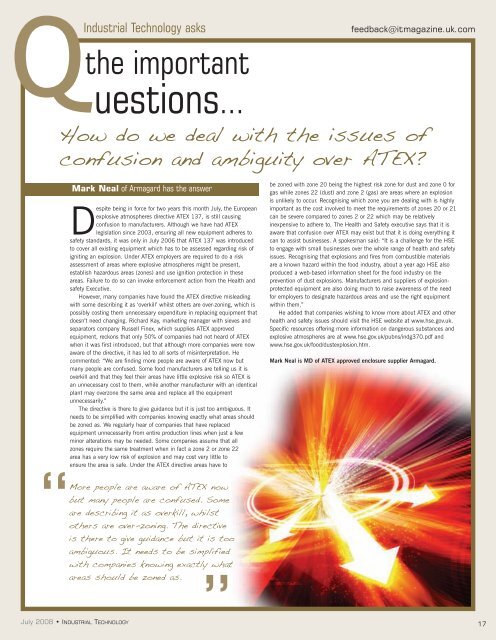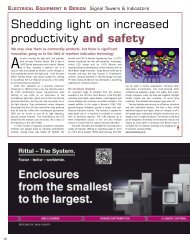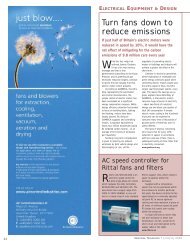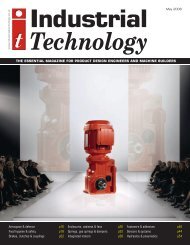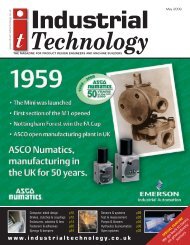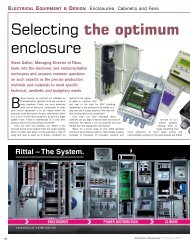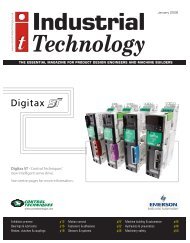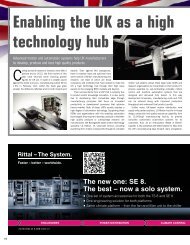ENGINEERING LITERATUREDatasheet forlong life batteryYuasa Battery has published a newdatasheet covering its latest longlife standby 12V valve regulatedlead-acid (VRLA) batteries that aredesigned especially for use intelecommunications power applications.The four page datasheet providesdetailed specifications and information onthe Endurance ENL100-12FT batteriesthat feature 15 year design life and havebeen designed from the ground up to fitinto standard telecom equipment racks.Both terminals are at the front of the cellmaking it easier to connect batteries whensituated in power cabinets.The battery shape is different fromstandard designs being longer andnarrower so that just a single row ofbatteries is required in a telecoms rack.The front terminal design makes it easierto connect multiple batteries in systemsand also makes maintenance and replacementof batteries a simple operation.Engineers can simply slide out andreplace a cell without having to reach overmultiple cells and connect top terminals.Want a copy? .........................Enter G163 on the cardGuides for your book shelfand the latest brochuresEvery month, your hard working <strong>Industrial</strong> <strong>Technology</strong> team bringsyou the best of the latest industry guides, the most interestingcatalogues, and news of important updates to supplier web sitesThe New Moss Plastic Parts2008 – 2009 catalogue ispacked with over 11,000components suitable formillions of applications andmarkets. The catalogue has over320 pages and features over1,500 new products, including;a vast range of PCB supports,new style hinges and latches,machinery mounting feet, adhesivefixings, display products and manymore.The new product offeringrepresents the latest phase in aperiod of rapid product enhancement.During the last five years, Moss havemore than doubled their productoffering in order to provide a one-stopsolutionto its vast array ofcustomers. Many existing ranges havebeen extended to include a widerselection of popular sizes andcoloured items.The easy to use cataloguecontains technical productinformation and is indexed and colourcoded by product type. Thecoloured sections detail solutionsto satisfy a wide range ofindustries, with all productsfeatured delivered from stockwithin 24 hours.The new catalogue is availablein both, traditional print and onlineformat. The web version offers asearch facility, allowing selection byproduct name, description or partnumber. In addition, free productsamples can be requested online, 24hours a day.“This is our best and mostcomprehensive catalogue ever,” saysMatt Taylor, managing director for thecompany.Want a copy? ................Enter G164 on the cardActuation systemsPower JacksThis 275 page design guidefrom Power Jacks providesdetailed information for the useof screw jacks, electric linearactuators, roller screws, bevelgearboxes and othercomponents for buildingcomplete actuation systems.A leading manufacturer ofthese products, Power Jackssupplies its components worldwideas individual units or ascomplete <strong>motion</strong> systems,focusing on precise actuation,power transmission, andmechanical jacking.DC motorsParvaluxParvalux has a new 164 pagecatalogue for its range of DCbrushed permanent magnetmotors and gearboxes. Thiscompletely revised edition isthe result of a thoroughdevelopment process, andreplaces all previous materialrelating to the product line.The catalogue details 15permanent magnet motors withIEC and NEMA mountingoptions, 107 gear-motorcombinations, a full range ofintegrated planetary gearedmotors, and various add-ons.Control solutionsHawco ControlsHawco Controls has justpublished its latest Quick Pickfocus product guide, whichdetails product ranges that arealways available off the shelffor immediate delivery. Nowcustomers have more than1000 products to choose from,and prices have been reduced.Hawco’s Simon Dugdalecomments: “The QP catalogueis one of a number of tools thatwe have established to helpwith our customers’ dailyproduct demands anddecisions.”Electric motorsOEM AutomaticNew from OEM Automatic is acomprehensive cataloguefeaturing Panasonic, one of thelargest motor manufacturers inthe world, which has designedand developed a new range ofCE/UL/cUL and CCC globallyapproved geared motors.They cover powers from 6to 90W with improved motorefficiency, and all ball bearinggearboxes are rated to 10,000hours lifetime. Motors in therange consist of single phase230V and three phase 230Vor 400V models.Bearing replacementNSKNSK’s new BearingReplacement Guide is acomprehensive specificationand selection guide, whichenables bearing users toconvert to NSK bearings fromother manufacturers’ that arein need of replacement, buthave been withdrawn or areunavailable.The guide’s layout andcontent have been specificallydesigned to help bearing usersselect the best type ofreplacement bearings for theirapplications.Want a copy? ....Enter G165 on the cardWant a copy? ....Enter G166 on the cardWant a copy? ....Enter G167 on the cardWant a copy? ....Enter G168 on the cardWant a copy? ....Enter G169 on the card16INDUSTRIAL TECHNOLOGY • July 2008
Q<strong>Industrial</strong> <strong>Technology</strong> asksthe importantuestions...feedback@itmagazine.uk.comHow do we deal with the issues ofconfusion and ambiguity over ATEX?Mark Neal of Armagard has the answerDespite being in force for two years this month July, the Europeanexplosive atmospheres directive ATEX 137, is still causingconfusion to manufacturers. Although we have had ATEXlegislation since 2003, ensuring all new equipment adheres tosafety standards, it was only in July 2006 that ATEX 137 was introducedto cover all existing equipment which has to be assessed regarding risk ofigniting an explosion. Under ATEX employers are required to do a riskassessment of areas where explosive atmospheres might be present,establish hazardous areas (zones) and use ignition protection in theseareas. Failure to do so can invoke enforcement action from the Health andsafety Executive.However, many companies have found the ATEX directive misleadingwith some describing it as ‘overkill’ whilst others are over-zoning, which ispossibly costing them unnecessary expenditure in replacing equipment thatdoesn’t need changing. Richard Kay, marketing manager with sieves andseparators company Russell Finex, which supplies ATEX approvedequipment, reckons that only 50% of companies had not heard of ATEXwhen it was first introduced, but that although more companies were nowaware of the directive, it has led to all sorts of misinterpretation. Hecommented: “We are finding more people are aware of ATEX now butmany people are confused. Some food manufacturers are telling us it isoverkill and that they feel their areas have little explosive risk so ATEX isan unnecessary cost to them, while another manufacturer with an identicalplant may overzone the same area and replace all the equipmentunnecessarily.”The directive is there to give guidance but it is just too ambiguous. Itneeds to be simplified with companies knowing exactly what areas shouldbe zoned as. We regularly hear of companies that have replacedequipment unnecessarily from entire production lines when just a fewminor alterations may be needed. Some companies assume that allzones require the same treatment when in fact a zone 2 or zone 22area has a very low risk of explosion and may cost very little toensure the area is safe. Under the ATEX directive areas have to“More people are aware of ATEX nowbut many people are confused. Someare describing it as overkill, whilstothers are over-zoning. The directiveis there to give guidance but it is tooambiguous. It needs to be simplified”with companies knowing exactly whatareas should be zoned as.July 2008 • INDUSTRIAL TECHNOLOGYbe zoned with zone 20 being the highest risk zone for dust and zone 0 forgas while zones 22 (dust) and zone 2 (gas) are areas where an explosionis unlikely to occur. Recognising which zone you are dealing with is highlyimportant as the cost involved to meet the requirements of zones 20 or 21can be severe compared to zones 2 or 22 which may be relativelyinexpensive to adhere to. The Health and Safety executive says that it isaware that confusion over ATEX may exist but that it is doing everything itcan to assist businesses. A spokesman said: “It is a challenge for the HSEto engage with small businesses over the whole range of health and safetyissues. Recognising that explosions and fires from combustible materialsare a known hazard within the food industry, about a year ago HSE alsoproduced a web-based information sheet for the food industry on theprevention of dust explosions. Manufacturers and suppliers of explosionprotectedequipment are also doing much to raise awareness of the needfor employers to designate hazardous areas and use the right equipmentwithin them.”He added that companies wishing to know more about ATEX and otherhealth and safety issues should visit the HSE website at www.hse.gov.uk.Specific resources offering more information on dangerous substances andexplosive atmospheres are at www.hse.gov.uk/pubns/indg370.pdf andwww.hse.gov.uk/food/dustexplosion.htm.Mark Neal is MD of ATEX approved enclosure supplier Armagard.17


